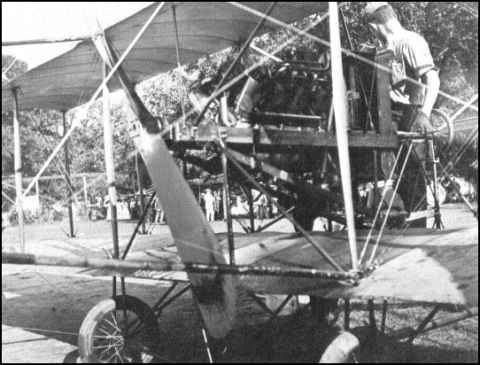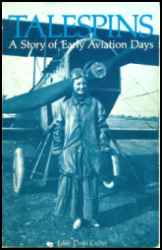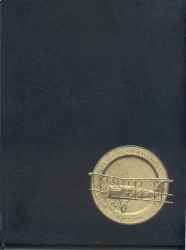
 |
|
from The Day The Airmail Began by Edith Dodd Culver |
|
by Edith Dodd Culver About the same time another pioneer aviator came to nearby Ironwood, Michigan, to do exhibition flying and Paul, (Paul Culver), was on hand there too to watch him uncrate the airplane parts and assemble what looked like a "jig-saw puzzle with motor." But the aviator, Jimmy Ward, put it together, warmed up the motor and took off. Paul marveled at the skill with which he handled his frail flying machine. Jimmy was one of the most popular of the early exhibition flyers and rightly so. We were to know him at Dayton, Ohio in 1917, but later to lose sight of him until on day Paul was solicited for funds to give Jimmy a worthy burial. It seemed that somehow, after his death in Florida, he had been buried there in a pauper's grave because there was no one to take charge. When his flyer friends learned of it they took up a collection to correct the sad mistake. They were determined that this indignity should not happen to one of the greatest of the pioneer flyers." Editor's Note:This story was excerpted from the wonderful book, The Day the Airmail Began by Edith Dodd Culver, Paul was her husband and one of the first airmail pilots. They both were lifelong friends of Walter and Loa Lees, the parents of my wife. I was privileged to know Edith (Aunt Teed) for several years before her death. She was a wonderful woman, good company, and filled with the stories of early aviators and aviation. I can heartily recommend both of her books to you, The Day The Airmail Began and Tailspins. |
 |
|
Ward's Curtiss Transcontinental Flyer called the Hurst Pathfinder just before he abandoned his attempt in Sept 1911 Collection of Jerry Blanchard, 11-15-07 |
|
Daily Journal and Tribune This info is substantiated in the Lebow book on Cal Rodgers. Ward flew in the Chicago Meet of August 1911. Ward flew a Curtiss biplane. Editor's Note: This article was found in the archives of the Daily Journal and Tribune by Bob Davis. I thank him for his initiative and for his generosity in sharing it with us on this website. |
|
SEEN BY CROWDS THE MOST DARING FLIGHTS YET MADE IN STATE. Exhibition at South Beach a Success but Utterly a Failure as a Financial Proposition. St. Augustine Evening Record St.Augustine, Florida, Monday, April 3, 1911 Collection of Beth Bowen, 11-15-07 Mr. Ward made several flights in the "Shooting Star" and in his most daring effort he carried McCurdy as a passenger. Besides straight flying the spiral glide was given and several daring feats with the big flying machine were successfully accomplished. From the standpoint of an exhibition it was a great success but from the standpoint of finances it was an utter failure. When the board of trade dropped the effort to bring aeroplanes here for flights Mr. Hopkins took the project up and brought them here himself. He was forced tp gp to heavy expense. The majority at the beach only paid their carfare and refused to pay the admission to the beach as it is government property and thus to add in helping to meet the expenses of the holding of the exhibition. Accordingly it acted as a damper on Mr. Hopkins' public spirit as his loss is no small one. The holding the meet here meant much for St. Augustine. |
|
EXHIBITION AT RACES Great Crowds Saw Yesterday's Events FAST TIME IS MADE Ace II, Vita and T. & S. Were the Winnders of Day's Events. Two Contests Today St. Augustine Evening Record St. Augustine, Florida, Thursday, April 6, 1911 Collection of Beth Bowen, 11-15-07 The second day of the Southern Championship races was the best yet. Ideal weather made the bay smooth and drew great crowds of spectators out. The Record Company and many of the business houses of the city suspended business at 2 o'clock in the afternoon to enaable their employees to witness the events. The Ace II of Eustls, the Vita of New York and the T. & S. of Jacksonville were the first winners of the three events of the day. And each race was a great contest. The St. Augustine City Band occupied the stand on top of the club house and rendered an excellent program throughout the afternoon. About 4 o'clock Ward arose in the "Shooting Star" from South Beach and soared over the lighthouse and Anastasia Island towards the city. Circling over Matanzas bay he lightly circled and lighted on a sand bar east of the channel and nearly opposite the fort reservation. Later he flew to the docks so that the crowds could see the machine working at close range and he then arose to a great height. When he circled into position and entered the contest with the speed boat, he easily out-distanced the swift little vessel. It was a great exhibition and Mr. Ward was the hero of the day with the crowds. The first event yesterday was in the morning and was a ten-mile handicap, free-for-all. The first prize of fifty dollars in gold went ot the Ace II of Eustls and the second of twenty-five dollars in gold to the T. & S. of Jacksonville. In this event as in most of the others many of the speedboats worked so well that they exceeded the time made in the trials and as a result the penalties cut down their time records on the corrected time. In the afternoon the twenty-mnile handicap for boats of twenty-five miles speed and better was won by the Vita of New York, she carrying off the first ;prize of seventy-five dollars in gold. The Elise of St. Augustine won the second ;prize of twenty-five dollars in gold...... |
|
The Daily Times, Chattanooga, Tennessee, Sunday, June 2, 1912, Transcribed by Bob Davis - 8-13-04 James J. Ward, an aviator, was arrested today on a charge of bigamy. His wife, Mrs. Maude Mae Ward, who yesterday sued for an annulment of her marriage, caused his arrest. Mrs. Ward charged in a warrant that her husband had a wife living when he married her. Ward was released on bond. |
|
|
|
© Copyright 2004 William L. Camp. All Rights Reserved. |
|
National Air and Space Museum, Smithsonian Institution This site describes the first crossing the the continent Calbraith Perry Rodgers in 1911 in his Wright EX biplane, There is a beautiful picture of the plane, on exhibit at the Museum, and a detailed description of the event. In the middle of the text you will find the following reference to James Ward. "In September 1911, three competitors were finally in the race. Cal Rodgers was one of them, along with Robert Fowler and James Ward. Fowler took off from San Francisco on September 11, but after three failed attempts to cross the Sierras, aborted his transcontinental flight by the end of the month. Ward took off from the east coast on September 13, but withdrew little more than a week later, not even making it out of New York State." You can access the site and read the entire fascinating story by clicking on the title above. |
 |
 |
A Story of Early Aviation Days by Edith Dodd Culver |
by Edith Dodd Culver |


|